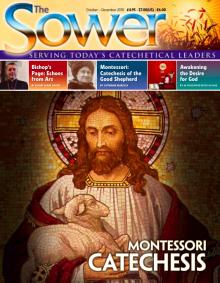‘Attractiveness’ is one of the keys of the pedagogy of the faith that Petroc Willey, Barbara Morgan and Pierre de Cointet write of in The Catechism of the Catholic Church and the Craft of Catechesis. In this work we are helped to see how essential this characteristic is considered to be by the Church. To encapsulate this point the Catechism of the Catholic Church has, on the front cover of every edition, the image of a shepherd playing panpipes to attract and comfort the sheep at his feet. Let us look at how to be attentive to the importance of this key in practice.
God himself is, of course, completely beautiful, utterly attractive. Catechesis is about God and therefore it is logical to think that in order to be true to the nature of God, beauty should in some way be integral to catechesis. Catechesis should be attractive, should attract. This raises many questions. What attracts people? What is a Catholic understanding of beauty? When we use the word ‘beauty’ in relation to catechesis, we need to be aware of both the physical resources we are using and, also, spiritual beauty, which has an attraction entirely its own. There can be spiritual beauty even in the midst of ugly physical surroundings. In this sense, we say, faith is beautiful, or, trust is beautiful. The beauty of trust in God can appear even in the most dismal and upsetting of surroundings.
The rest of this online article is available for current Guild members.
This article is from The Sower and may be copied for catechetical purposes only. It may not be reprinted in another published work without the permission of Maryvale Institute. Contact [email protected]

















